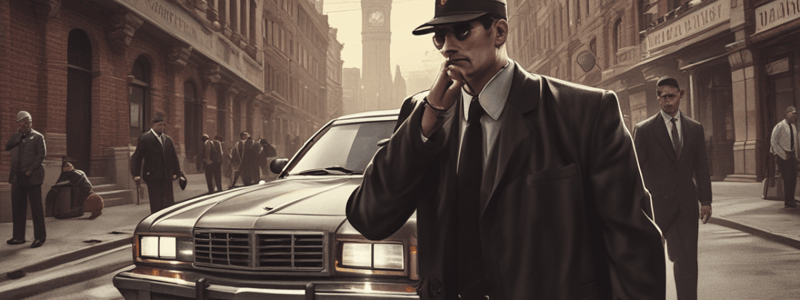Podcast
Questions and Answers
What are the three essential elements necessary to constitute a robbery?
What are the three essential elements necessary to constitute a robbery?
- Taking of personal property, with the possessor's consent, and against the possessor's will
- Taking of personal property, by force or fear, and with the possessor's consent
- Taking of personal property, against the possessor's will, and with the possessor's consent
- Taking of personal property from the person or presence of a possessor, against the possessor's will, and by force or fear (correct)
What is a major problem encountered in robbery investigations?
What is a major problem encountered in robbery investigations?
- Uncooperative witnesses
- Low-risk factor to both the victim and the responding police officers
- High-risk factor to both the victim and the responding police officers (correct)
- Lack of evidence at the crime scene
What is the primary objective of a robbery investigation?
What is the primary objective of a robbery investigation?
- To identify the skill levels of robbers and characteristics of each level
- To identify the procedural steps in a robbery investigation
- To identify the essential elements of a robbery (correct)
- To identify the major styles of robberies and how they relate to suspect identification
What is the major objective of a preliminary investigation in a robbery?
What is the major objective of a preliminary investigation in a robbery?
What is the focus of a robbery investigation?
What is the focus of a robbery investigation?
What is one of the primary objectives of a criminal investigation?
What is one of the primary objectives of a criminal investigation?
What is typically relied upon to determine the possibility of physical evidence in a robbery case?
What is typically relied upon to determine the possibility of physical evidence in a robbery case?
Why are robbery victims often unreliable or ineffective witnesses?
Why are robbery victims often unreliable or ineffective witnesses?
What is often used to identify a robbery suspect when there is no physical evidence?
What is often used to identify a robbery suspect when there is no physical evidence?
What type of robbery is often characterized by a weapon being displayed or indicated?
What type of robbery is often characterized by a weapon being displayed or indicated?
What is often a characteristic of an unarmed robbery suspect who uses a note or threat?
What is often a characteristic of an unarmed robbery suspect who uses a note or threat?
What is the typical target of a commercial robbery?
What is the typical target of a commercial robbery?
What type of robbery often involves a minimum of planning and some casing?
What type of robbery often involves a minimum of planning and some casing?
What is often a characteristic of a street robbery?
What is often a characteristic of a street robbery?
What type of robbery is often characterized by a professional criminal with escape plans ready?
What type of robbery is often characterized by a professional criminal with escape plans ready?
What is often a characteristic of a planned operation robbery?
What is often a characteristic of a planned operation robbery?
Flashcards are hidden until you start studying
Study Notes
Elements of a Robbery
- A robbery requires three essential elements: taking of personal property from a person or presence, against the possessor's will, and by force or fear.
Problems with Robbery Investigations
- High-risk factor for both victims and police officers.
- Little or no physical evidence at the robbery scene, relying on witness statements.
- Robbery victims are often unreliable or ineffective witnesses due to emotional stress and short time span of the robbery.
Methods and Styles of Robberies
- There are two basic methods: armed and unarmed robberies.
- Armed robbery: weapon is displayed or indicated, with a professional or aggressive behavior.
- Unarmed robbery: no weapon is displayed, with a desperate or spontaneous behavior.
Styles of Robberies
- Ambush: little or no planning, random victim selection, low score, and usually committed by unskilled or semi-skilled robbers.
- Selective Raid: involves some planning, moderate score, and usually committed by semi-skilled robbers.
- Planned Operation: involves extensive planning, high score, and usually committed by professional robbers.
Major Types of Robberies
- Residence: planned residential robbery, often involving a group and a ruse to gain entry.
- Vehicle: taxi cab driver, bus, or other vehicle robbery, often involving secluded areas and few passengers.
- Commercial: usually involves a weapon, commonly a handgun, and targets convenience stores, grocery stores, liquor stores, and gas stations.
- Street: usually involves at least two assailants, targeting women, elderly, and intoxicated persons, often at night in secluded areas.
- Bank: formerly involving professional criminals, now amateurs and militant groups, often involving a weapon or note to teller demanding money.
Studying That Suits You
Use AI to generate personalized quizzes and flashcards to suit your learning preferences.




